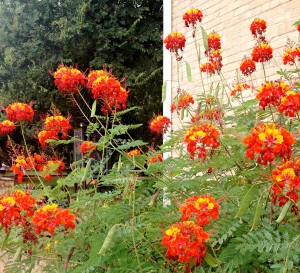Whenever I was deciding on where I wanted to spend my time observing nature for an hour each week throughout this semester, I was dreaming big and looking for these beautiful, hidden places that nobody would know about that I could expose. As the time grew nearer for me to decide on where I would choose to talk about, I started to notice all the curious things that are found on our very own campus. I began walking slower as I traveled from class to class, just so I could get a better glimpse of what was in the trees or giggle as a squirrel snuck up on a bird. Not once did I think about how it would relate to my environmental science class. I was just in awe of how such a small part of our earth could be home to all these beautiful things.
One of the first things that caught my attention were the vivid, gorgeous flowers growing by the building located between Jo’s Cofee and Moody Hall (I believe it’s called the Carriage House). You would think that it would be hard to miss them, but in between trying to get to class on time, checking your phone for text messages, talking to the people walking beside you, and stressing about what you’re doing next, you forget to stop and smell the flowers (literally). Whenever I had finally noticed them I had to stop what I was doing and I send a photo to my grandma:
I’m not one to know a whole lot about plants, but I knew that my grandma, being the adorable flower lover she is, would know exactly what they were and would be able to give me a little bit of detail about them. She responded right away and informed me that they are called “Lantana”. She told me that they grew in Dallas, my hometown, but they didn’t get big because they freeze every year. For some reason, something clicked for me and I realized that I didn’t have to be out at a nature preserve or a hidden creek to have an impressive nature blog for my environmental class, but instead I could show people the wildlife we fail notice in our very own backyard.
Over the past few weeks of September I have notice many things around the campus that I am thrilled to share, but one of the most curious things I noticed was this:
For the longest time I could not figure out what they were, but then in one of our environmental classes we learned about epiphytes, which are plants that grow on other plants in a non-parasitic way. So I turned to the most reliable source I know, Google, and searched “austin epiphytes.” The first thing that popped up was “ball moss” and it’s almost embarrassing how excited I was when I discovered it was a match.
Ball moss, scientifically called tillandsia recurvata, is a small epiphyte in the bromeliad family (which contains pineapple, ferns, orchids, and spanish moss) that is commonly found clinging to the limbs of live oaks and other trees in southwest Texas. Contrary to its name, ball moss is not a moss, but a plant with flowers and seeds. It anchors its pseudo-roots into the bark, but doesn’t take nutrients from the tree; rather, it lives by absorbing water and nutrients from the atmosphere. It grows toward the interior canopy of trees (as seen below) because their ideal environment consists of low sunlight intensity and high humidity. The moss is known to fix nitrogen from the atmosphere and eventual it adds to the soil. It also harbors small bugs which serve as food for several types of birds.
Learning about something little like the ball moss has really opened my eyes and excited me to find more things like it around campus. It’s amazing how something so cool and unique can easily be overlooked. It made me think of the following quote found in A Sand County Almanac, “The problem, then, is how to bring about a striving for harmony with land among a people many of whom have forgotten there is any such thing as land, among whom education and culture have become almost synonymous with landlessness.” It is too often that we don’t recognize how important the environment is to our lives, and how we owe our existence to this wonderful world we are blessed with. Today we spend so much time glued to a little computer we hold on our hands, when we don’t even realize that there is so much to be seen outside of the screen.



